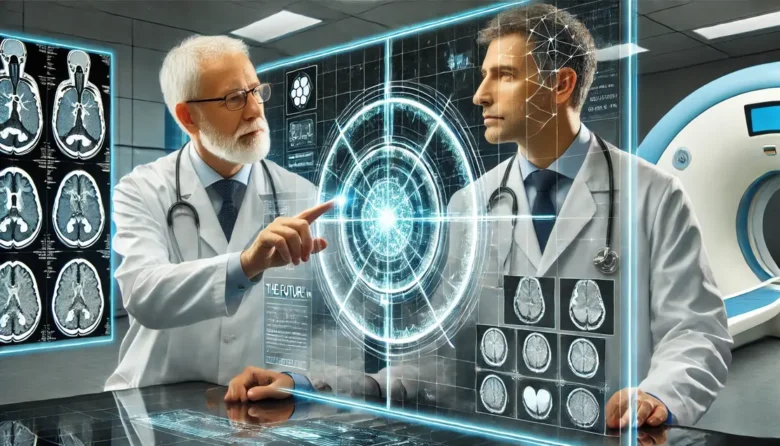Imagine a future where intelligent assistants, silently and tirelessly analyzing data, can detect diseases years before the first symptoms, without the need for invasive tests. This is no longer science fiction but reality: artificial intelligence will revolutionize healthcare by 2025. The convergence of AI and medical diagnostics goes beyond simple automation and leads to a new paradigm of predictive, personalized, and precision medicine. We are witnessing a dramatic shift in healthcare from reactive to proactive approaches, with algorithms becoming powerful assistants for physicians, enhancing their skills and revealing insights hidden deep within complex biological realities.
This transformation is not about replacing human intervention but about enhancing it with unprecedentedly large-scale and highly accurate tools that have the potential to redefine patient outcomes and optimize global healthcare systems. The stethoscope of the future is digital, driven by silicon chips and algorithms, and it has already begun to listen.
The Rise of Predictive Diagnostics:
The most significant leap in 2025 will be the shift from diagnostics to predictive analytics. Artificial intelligence systems are currently being trained with massive multimodal datasets, including genetic information, proteomics, historical electronic health records, and even real-time data from wearable devices. These algorithms are capable of detecting subtle patterns and correlations that are not visible to the human eye.
For example, by looking at regular blood test results along with genetic information and lifestyle choices, AI can figure out a person’s unique risk level for diseases like Alzheimer’s, some cancers, or heart disease many years ahead of time. This shift enables preventive lifestyle interventions and monitoring, fundamentally changing the patient’s treatment path from treatment to prevention and early treatment. This transformation has the potential to save countless lives and alleviate the burden on healthcare infrastructure.
Improving Medical Image Interpretation:
Radiology and pathology have become central to AI innovation. Advanced deep learning algorithms are now the main tools used to interpret magnetic resonance imaging (MRI), computed tomography (CT), and digital pathology slides, greatly accelerating the process and helping to clear the backlog of diagnoses. These algorithms excel at detecting minuscule abnormalities, such as tiny spots on lung scans that indicate early cancer or subtle changes in brain tissue that predict the onset of multiple sclerosis.
By 2025, this technology will go beyond mere detection and focus on functional analysis, enabling AI to not only detect tumors but also predict their invasiveness and potential response to specific medications based on their radiological characteristics. This provides radiologists and oncologists with a powerful decision-support tool, increasing diagnostic certainty and paving the way for highly personalized treatment plans, benefiting the entire care process.
Streamlining Workflows and Reducing Burnout:
The profound impact of AI on diagnosis is often overlooked: it transforms the way physicians work and helps them prevent burnout. Healthcare has long struggled with administrative and diagnostic tasks. AI solutions can now automate tedious tasks such as transcribing clinical notes, prioritizing critical cases on radiologists’ to-do lists, and pre-populating initial findings reports.
This intelligent automation frees physicians to focus on challenging cases, communicate directly with patients, and make strategic decisions. As an efficient assistant, AI alleviates the cognitive burden that leads to burnout, creates a more sustainable work environment, and ultimately empowers clinicians to perform optimally and provide better patient care.
Integration and Ethical Challenges:
Despite promising prospects, the widespread integration of artificial intelligence (AI) into mainstream diagnostics also faces challenges. Key hurdles include ensuring the robustness and fairness of algorithms across different patient populations to prevent biased outcomes. The “black box” dilemma—where some AI conclusions are difficult for humans to understand—remains a concern for regulators and clinicians who must trust and understand the basis for their diagnoses.
Furthermore, issues such as data privacy, security, and establishing a clear legal framework for ongoing validation are crucial. Successfully navigating this area requires collaboration between technology experts, medical professionals, ethicists, and policymakers to design systems that are not only robust but also transparent, fair, and trustworthy.
The Future Is Collaborative Intelligence:
The growth of artificial intelligence (AI) in medical diagnostics is a sign of the rise of collaborative intelligence. In the future, AI will not diagnose independently but rather through collaboration between humans and machines. The combination of clinicians’ professional knowledge, intuition, and empathy with AI’s computing power, pattern recognition capabilities, and data processing capabilities will form a diagnostic team that surpasses its individual components.
This collaborative model is likely to expand into areas such as drug development and personalized treatment planning, where AI will help create treatment plans based on individual, unique diagnostic characteristics. The ultimate goal is to create a human-centered, technology-enabled healthcare system that offers more accurate, convenient, and humane treatments than ever.
Conclusion:
The journey toward integrating AI into medical diagnostics has already begun and represents an important chapter in medical history. We are moving from an era of experience-based guesswork to a data-driven, high-certainty era where early detection becomes the norm, not the exception. This technological change aims to make expert knowledge available to everyone and provide top-notch diagnostic tools, even in remote or less developed places, thanks to cloud-based AI technology.
While challenges remain regarding trust and integration, its potential to save lives, minimize misdiagnosis, and create a more efficient global healthcare ecosystem is undeniable. Physicians remain indispensable on the front lines of clinical care, but with AI as a powerful assistant, they can combat diseases with unprecedented accuracy and foresight, leading to a better, healthier future for all of humanity.
FAQs:
1. Will AI replace radiologists and physicians?
No, AI is designed to support healthcare professionals, not replace them. It is a powerful tool for performing data-intensive tasks, allowing clinicians to focus on complex decisions and patient care.
2. How accurate is AI’s medical diagnosis?
AI diagnostic techniques can sometimes match or even surpass the accuracy of human experts in specialized tasks such as image analysis. However, their success depends on the quality and diversity of the training data.
3. Is my medical data safe in AI systems?
Reliable AI systems use strong anonymization mechanisms and comply with strict data protection requirements, such as HIPAA. Security and patient privacy are paramount in their development and implementation.
4. Can AI algorithms be biased?
Yes, if AI is trained with unrepresentative data, it can be biased. The industry is actively working to generate more diverse datasets and fair algorithms to provide fair results for all patient groups.
5. Will AI increase diagnostic costs?
Initially, it may increase costs, but in the long term, AI is expected to reduce healthcare costs by identifying diseases earlier, preventing unnecessary surgeries, and optimizing operational processes.




